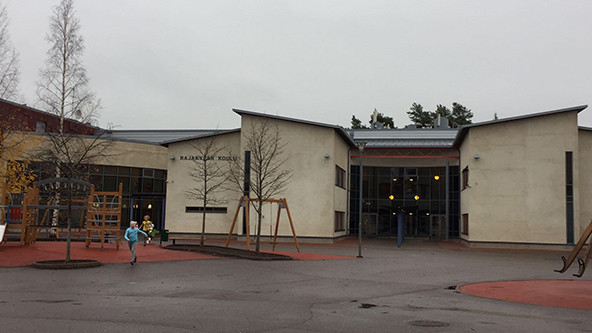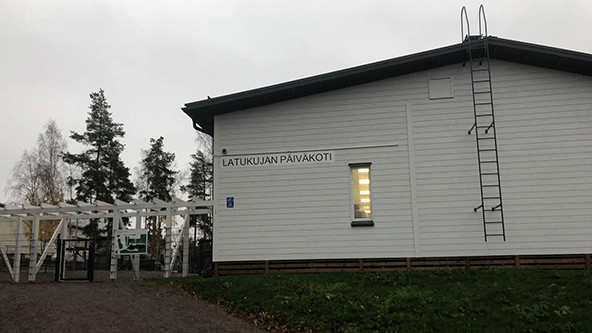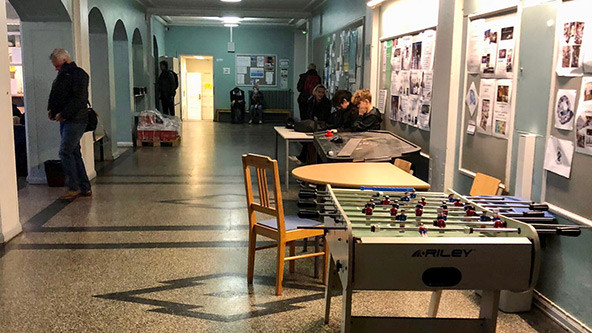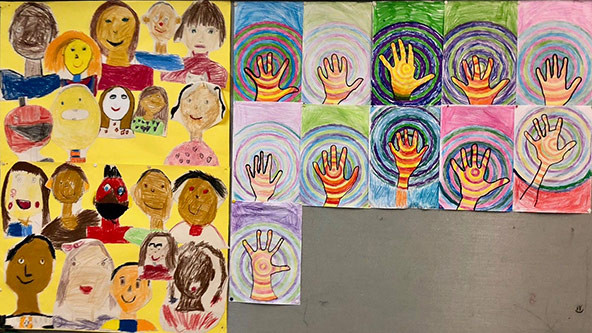 Rajakylän Koulu is a primary school in Vantaa, Finland, serving 700 students in grades 1-9. (Photo by Matt Morton)
Rajakylän Koulu is a primary school in Vantaa, Finland, serving 700 students in grades 1-9. (Photo by Matt Morton)
What happens when a country decides that one of its most precious natural resources is its children? Finland’s educational system provides a clue. New scores on the Organization for Economic Cooperation and Development’s (OECD’s) Programme for International Student Assessment (PISA) test are set for release in December 2019 and will draw the attention of education leaders as a measure of which countries best educate their children. American students ranked 31st on the most recent iteration of the exam, which tests 15-year-olds around the world on multiple subjects. Finland, on the other hand, has won international acclaim since it first topped PISA’s charts in 2000. Not only did it remain there several rankings in a row, but also its students displayed remarkably low variability across schools (8 percent versus 30 percent OECD-wide) and within schools. In other words, even Finland’s below-average schools still prepare students to succeed in their personal and professional lives.
How Finland has achieved these results makes it particularly relevant for US reformers. Rather than focusing efforts on new schools, programs, and technology, it has taken a sustainable approach that leverages education infrastructure and spending similar to that of the United States. In 2016, the Finnish National Education Agency reported that Finland spent the equivalent of about $10,000 per student on basic education—less than the US average and about half of what top-spending states dole out. Furthermore, Finland’s success cannot be attributed solely to societal differences. As Columbia University’s Samuel Abrams has noted, Finland’s scores have surpassed those of other Nordic countries despite similar levels of child welfare, social support, and homogeneity. Improvements within the last few decades are products of sound policy and practices.
Finland has approached education reform as a strategy to leverage the country’s scarce natural resources. As one Finn put it, “We have only our forests and our people.” Accordingly, its approach has been holistic, student-centered, and focused on teachers as the main driver of quality. It has defined education as a way to “support pupils’ growth into humanity and into ethically responsible membership of society and to provide them with knowledge and skills needed in life.” Culturally, this manifests in a focus on student well-being in all of its facets. American education reform, on the other hand, has focused on increasing standards and accountability measures ever since the 1983 Nation at Risk report identified failing schools as a primary threat to American economic dominance.
On the surface, Finnish schools don’t look very different from the traditional American model. Students, grouped by age, visit a brick-and-mortar building and learn from a teacher in a classroom for a defined period of time. Yet underlying the Finnish system are fundamental differences in policy that produce better outcomes for students. Ironically, many of these effective practices stem from American research and thought leadership, at least according to Finnish education expert Pasi Sahlberg. Finland can therefore provide a helpful blueprint to implement what we already know works within the schools we have now, while American innovators continue to experiment with new models for the future.
Are you enjoying this article? Read more like this, plus SSIR's full archive of content, when you subscribe.
In November 2018, our organization, Future School Lab, organized an expert-led tour of Finnish schools and meetings with education leaders as part of HundrED’s Education Innovation Summit. When we reflected on the experience, we came away with four main reforms any US state or school could implement to make sustainable improvements within the current system.
1. Articulate a Target Profile for Graduates That Informs Education Policy
Finnish education is based on a clearly stated vision of target abilities, rather than prescriptive, content-based curriculum. In 2016, following a co-creation process that included public input and 30 working groups, the Finnish government defined seven transversal skills and knowledge areas important to students’ success in life:
- Thinking and learning to learn
- Cultural competence, interaction, and self-expression
- Taking care of oneself and managing daily life
- Multi-literacy
- Information and communications technology competence
- Working life competence and entrepreneurship
- Participation, involvement, and building a sustainable future
These competencies are aspirational rather than fixed benchmarks; they define a relevant vision of how all students can function in society, rather than specific content knowledge. Local municipalities and schools adapt this curriculum to their context and classrooms, and since there are no national achievement tests, the Finnish National Agency for Education can focus on effectively integrating this shared vision into curriculum and school policy, rather than on accountability.
In the United States, some schools, districts, and even a few states are beginning to reorient education toward the development of a more-holistic set of skills, similar to Finland. The Mastery Transcript Consortium, founded by a group of elite private schools with increasing public school membership, for example, is cocreating a digital transcript that reflects each student’s skills, strengths, and interests far beyond the course completion version schools use today. And to help schools looking to articulate a more-holistic vision for their graduates and engage communities in a visioning process, Transcend Education (with which the authors are affiliated) has created a database that provides research-based measures to evaluate learning outcomes for social-emotional skills like empathy and sense of purpose.
2. Recruit Talented Teachers, Train Them Well, Then Give Them Autonomy
Finland attributes its success in education to getting the right people to become teachers, developing them into effective instructors, and putting systems and supports in place to ensure that all children benefit from excellent instruction. Teacher training programs are competitive (admitting about 1 in 10 students) and rigorous. The profession is highly regarded despite average pay as compared to other OECD countries, and according to the Finnish National Agency for Education, 90 percent of teachers report being satisfied with their job.
These high marks are due in part to the trust and autonomy Finnish teachers have. Local governance elevates their voices in policymaking. School boards must, by law, include teachers alongside parents, classified staff, and students. Freed from teaching to the test, teachers can focus on project-based learning (called “phenomenon-based learning” in Finland), and other, deeper learning approaches that we know work for students but that American teachers sometimes avoid for fear of sacrificing content standards.
Finnish teachers also have more time. Because school days are shorter and teachers spend fewer hours in classroom instruction—about 55 percent of US teachers’ annual hours—they devote more time to preparing lessons, collaborating with colleagues to create engaging projects, and meeting with parents and kids.
In the United States, on the other hand, districts struggle to recruit and retain qualified teachers. Recent teacher walkouts reflect frustration over more than pay and insufficient school funding. Seventy-one percent of teachers in a 2015/2016 survey reported a lack of influence over what they teach, 50 percent said they lacked support and encouragement from administration, and 62 percent didn’t experience a great deal of cooperation among colleagues.
 Latukujan päiväkoti is a nursery and preschool in a socio-economically diverse area of Helsinki with a high immigrant population. Finnish students have a right to high-quality early childhood education starting at 10 months of age. (Photo by Kali Thorne-Ladd)
Latukujan päiväkoti is a nursery and preschool in a socio-economically diverse area of Helsinki with a high immigrant population. Finnish students have a right to high-quality early childhood education starting at 10 months of age. (Photo by Kali Thorne-Ladd)
To develop a larger pool of qualified teachers, schools can make use of alternative pathways to certification by recruiting high-potential teachers with skills and lived experiences that are relevant to students. For example, Roosevelt High School in Portland, Oregon, recruited award-winning journalist S. Renee Mitchell through a professional track that leveraged her career experience but required college courses to learn classroom skills. Mitchell quickly became an important role model and impactful educator. She entered the school, one of Oregon’s most diverse, as its only black teacher, and created the nationally recognized I Am M.O.R.E. program to elevate the voices of students who have experienced trauma. In the longer term, policy makers need to create and fully fund career pathway programs for promising teachers from all backgrounds. Beyond recruitment, we need to invest in ongoing training and support systems, and give teachers time and autonomy to collaborate and integrate new methods and ideas.
3. Give Students Rights and Agency Over Their Own Learning
In Finland, the 1998 Basic Education Act entitles students to pre-primary education, a safe learning environment, and instruction that includes guidance counseling and learning support. In our experience, teachers and administrators routinely referenced children’s rights to explain shorter days, healthier lunches, less homework, and 15 minutes of physical activity for every 45 minutes of class. Legislation based explicitly on students’ rights not only informs practices, but also supports underlying expectations of how education should work. This model places students at the center, creating a decision-making framework that prioritizes their learning and interests over pleasing parents or reporting high test scores. It also justifies giving students more of a say in the policies that affect them. After all, who better to advocate for student interests than students themselves? As a result, students in Finland have real responsibility, including authority over parent-teacher meetings and positions on school boards, and teachers expect students to be the primary agents in their own educational journeys.
 We noted plenty of comfortable areas for students and staff to congregate in every school we visited. One school even had a massage chair in the teacher’s lounge. (Photo by Vanessa Wilkins)
We noted plenty of comfortable areas for students and staff to congregate in every school we visited. One school even had a massage chair in the teacher’s lounge. (Photo by Vanessa Wilkins)
In the United States, a missing parent permission slip can exclude a child from the best field trip of the year or an important learning opportunity in class. Such policies reflect the expectation that students should receive the education given to them, rather than take a proactive role in it. Perhaps one way to engage students and encourage them to take ownership of their own education and school experience is to quite literally give them ownership. Some districts, such as Los Angeles, have already introduced ballot measures that would lower the legal voting age to 16 for school board elections. Others have given students voting positions on school boards and site councils. In Maryland, student board members have advocated for their young constituents by introducing resolutions to dismantle student ranking systems and diversify schools by redrawing boundaries. Absent legislative changes, individual schools can develop student ownership by giving students voice and choice in how they learn. The Achievement Gap Institute at Harvard University’s “The Influence of Teaching” provides a useful study of teaching practices that drive student agency.
 Student art is displayed prominently in all schools. These primary school portraits hint at a desire to support a less-homogeneous student body. (Photo by Kali Thorne-Ladd)
Student art is displayed prominently in all schools. These primary school portraits hint at a desire to support a less-homogeneous student body. (Photo by Kali Thorne-Ladd)
4. Align Schools and Social Support Services
In Finland, education legislation guarantees free pupil welfare, meaning it integrates health care referred to in the Public Health Act, and mental and social services referred to in the Child Welfare Act. This legislation forms the basis for Student Welfare Committees comprised of principals, special education teachers, nurses, psychologists, social workers, and counselors. Committees meet regularly to discuss individual students and staff, and to create personalized support plans. These may include emotional or academic support services or intensive supplemental support, which benefits 10 percent of Finnish students. While a similar 14 percent of students receive special education services in the United States, what’s unique in Finland is the integration of health and welfare into the school day for both students and staff. School psychologists and social workers on the Welfare Committees meet with students individually and then make referrals to outside services as needed. During school, all students and staff eat free, healthy meals prepared on site, and active, outdoor play and social breaks throughout the day are the norm.
Many schools and programs in the United States, such as Communities in Schools, have already created successful local partnerships with social service providers. However, the onus is on schools to find and partner with community resources and creatively meet students’ needs. Funders and policy makers should support the coordination and development of wrap-around services to take the burden off of schools, and foster community and family engagement, which we know helps students succeed.
A Path Forward for All Kids
Educators and policy makers interested in adapting Finnish approaches to the American context must be mindful to create culturally competent learning environments that serve all children. Finnish policies are intended to promote equity by balancing socio-economic diversity across school boundaries, providing native language services to immigrants, and reducing barriers to nutritious food, health, and social services that contribute to disparities in the United States. However, student rights in Finland prevent the disaggregation of data to determine whether these inclusive measures truly do result in better outcomes for immigrants and historically underserved populations. Any effort to improve educational outcomes must include data-driven equity practices and community-led solutions.
Finally, reforms to our current system must coincide with new solutions for excellence and equity. In the United States, collaboration between public and private sectors, and a cultural emphasis on leadership and entrepreneurship have led to the creation of completely new school models in small pockets across the country. The best of these models may help determine the future of education and better prepare kids for the demands of a rapidly changing workforce. However, until we can test and scale them, they are only a drop in the ocean of the American school system. We need to simultaneously make improvements within our current system to better serve all students.
Support SSIR’s coverage of cross-sector solutions to global challenges.
Help us further the reach of innovative ideas. Donate today.
Read more stories by Vanessa Wilkins & Emily Corrigan.

